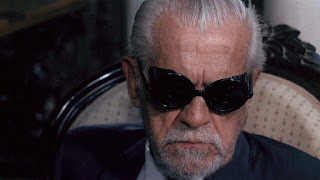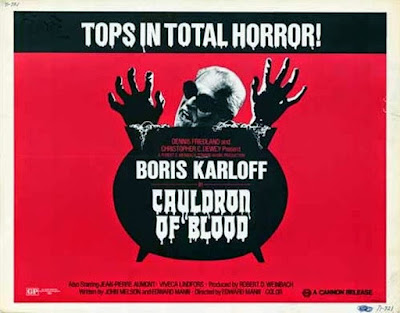Arriving at a rundown, gypsy-infested tourist trap-cum-artist colony somewheres along the coast of Spain, swingin' travelog writer Claude Marchand (Aumont) begins searching for an "in" to get himself an audience with the famed but notoriously reclusive sculptor, Franz Badulescu (Karloff), for a rare interview. And find it he does at a local cantina, where the owner, Shanghai (Quesada), steers him toward another local artist named Valerie (Monteros), who, along with her favorite model and sun-bathing enthusiast, Elga (Zurakowska), is good friends with Badulescu's wife.
Now, Tanya Badulescu (Lindfors) is a bit of an odd duck. Plagued by some bizarre nightmares that have there roots in repressed childhood memories from the war of being whipped and beaten by what appears to be a reasonable facsimile of Ilsa, She-Wolf of the SS (1975), Tanya comes off a bit unhinged as she appears to be channeling her former tormentor, judging by her leather outfits, closet full of whips, and a seemingly pathological need to lash out and torment Pilar (Speed), her deaf and dumb maid.
Tanya is also very overprotective of her decrepit husband, which is odd since he is constantly accusing her of trying to kill him. In fact, he claims she caused the accident that recently crippled and blinded him. A notion, one notes, she doesn't really confirm nor deny -- he typed ominously...
Anyways, still needing to make money, Tanya is helping out with her husband’s latest commission; a three-dimensional re-creation of some famous painting involving two women, a dog, and a deformed man.
Enter Marchand, who asks the artist, known for his uncanny realism, about the rumors he uses actual animal skeletons for his armatures. But the Badulescus skirt this question and Tanya quickly cuts the interview off and escorts the reporter and Valerie to the door.
Once they're gone, more marital barbs fly about the origin of the support structure of this latest sculpture, which is only half completed thus far (-- the man and the dog). And while those long held rumors prove true, and Tanya insists the bones were dubiously procured from a nearby cemetery, the viewer can't help but connect some earlier scenes of an unknown trench-coat boogeyman stalking and killing a hunchbacked beach bum and a stray mutt.
Also, as she puts her distraught husband to bed (-- and gives him an injection to make sure he stays there), Tanya announces she has a line on the skeletons needed to complete the piece. And as she predatorily leers at the original painting, one also can't help but notice how the two damsels bear more than a striking resemblance to Valerie and Elga -- he typed ominously, again...
You know, I had heard nothing good about the films of Boris Karloff post Peter Bogdonivich's Targets (1968). And though I freely admit Cauldron of Blood (1970) isn't all that good by any stretch, or breaks any new ground, genre wise, I still found myself digging it -- in an errant puppy's first encounter with a slide-whistle sense. The film is a complete mess, sure, but it’s an interesting mess. Okay, fine: an interesting and completely disposable mess that, I think, is still worth at least one spin on your system, mostly due to Viveca Lindfors's outré performance as the Big K's conniving wife.
An American-British-Spanish co-production, technically, Cauldron of Blood -- a/k/a Blind Man's Bluff predates Targets, the film most Karloff fans wished was the final coda to a staggeringly awesome career as the King of the Boogeymen and not Fear Chamber (1968), Isle of the Snake People (1971) or Alien Terror (1971). Apparently, it was shot in 1967 but was subsequently shelved until its eventual release in 1970 to, perhaps, cash-in on the horror star's death in late 1969.
A troubled production from the very beginning, with shaky financing and a last minute cast change, Karloff wasn't even intended to be in the film. Seems producer Roberth Weinbach -- Hallucination Generation (1966), The Freakmaker (1974), had originally cast Claude Rains in the role of the sculptor, but the actor's own health woes and untimely death had the production scrambling for a replacement.
Enter Karloff, who, to be honest, hardly appears in the film. (He doesn't even garner top-billing.) Basically reduced to a human set-piece, like his replacement, Glenn Strange, in those later Universal Monster Rallies -- House of Frankenstein (1944), House of Dracula (1945), this is understandable, considering the actor's own deteriorating health. One tries not to cringe as he painfully putters around, always the trooper, giving co-directors, Santos Alcocer and Edward Mann, everything he can. I just wish his reward for these efforts had been a better film.
I guess if a person wanted to be generous, you could consider Cauldron of Blood a transition piece between the Gothic melodramas of the late 1950s and the grittier, sleazier, and a whole lot bloodier Euro-Shockers of the late 1960s. By the time this film was made, the cryptic kookiness of the German Kriminalfilm or krimi -- The Fellowship of the Frog (1959), The Dead Eyes of London (1961), and the sex and sleaze of the Italian gialli -- Blood and Black Lace (1964), The Possessed (1965), were really starting to rev-up. And while the former helped inspire the latter, influences were now going both ways; so much so that it was getting harder and harder to tell them apart by the time you got to What Have You Done to Solange? (1972) and The Seven Bloodstained Orchids (1972).
Cauldron of Blood draws heavily from this cross-pollinated gene pool and, well, this kind of cinematic inbreeding is bound to produce some defects. All the proper genetic markers are there and, in more competent hands, they might've really had something -- something a little less tedious and a lot less plodding, one would hope. As is, the film is stuck in some sort of nebulous limbo, where it isn't suspenseful enough or sleazy enough or even stupid enough to be entertaining on any level.
Thus, Cauldron of Blood's problems are many. Predictability being another one. The pilfered Mystery of the Wax Museum (1933) / House of Wax (1953) plot is easily sniffed out before the first reel expires, and that Tanya is behind it all before the second. And from there, it's hampered by too many irrelevant subplots (-- slightly pink herring, gratuitous fortune telling, and a beach-front land grab), one real dunderhead of a hero (-- who engineered that land grab), and the Art of Noise-style soundtrack is a tad disjointing. As was the editing in general.
And yet, just when I was about to write the whole thing off, the film would refocus on Lindfors' Tanya being all whackadoodle again as she spins a lesbianic web to ensnare Elga, who is murdered by Tanya's secret lover (the Trenchcoat Boogeyman) and taken to a hidden chamber underneath the Badulescu estate, where her body is dipped in a huge vat of acid and reduced to a pile of bones. (And like in a lot of these movies, the acid eats through everything except the ligaments, 'natch.) And though these sequences don't quite reach an escape velocity to outer-delirium, well, it was close enough for me.
And as we reach the climax, the ever-worthless Marchand wanders off to watch some belly-dancers at the gypsy camp, leaving Valerie to unravel the disappearance of Elga. And unravel it she does, getting herself kidnapped in the process, trussed up, and bundled off to Tanya's secret lair.
Meanwhile, a suspicious Franz manages to stumble upon this hidden lair and catches his wife before her latest victim is dipped. And while the Badulescus brawl below, our *ahem* 'hero' finally blunders in and has the world's most clumsiest Batman ‘66-esque kerfuffle with the Trenchcoat Boogeyman (-- whose identity is all too obvious). And all of that leaves us with a post-climax coda, where a distraught Franz completes a murder-suicide ritual in an embarrassingly bizarre skip-framed-fueled sprint to the cliffs and the ocean below. I'm telling ya, all that was missing was a Boots “Yakety Sax” Randolph serenade.
So, yeah, Cauldron of Blood is a mess of poor directorial choices, script predictability, and wasted potential everywhere else. However, I will offer one caveat on this assessment. There's a pretty good chance I watched a TV-cut of Cauldron of Blood via YouTube. That, or the editing was even more incompetent than I thought. And if you do feel brave enough to give it a spin after reading this, I fear a pre-apology might be in order:
The sets and production design were sufficiently trippy, I guess. Rosenda Monteros and Dyanik Zurakowska are completely adorable. And the opening credits were kinda cool. As for the remaining 90-odd minutes ... Well, just cling onto Karloff and Lindfors as tight as you can.
Originally posted on December 6, 2014, at Micro-Brewed Reviews.
Cauldron of Blood (1970) Producciones Cinematográficas Hispamer Films :: Robert D. Weinbach Productions :: Tigon :: Cannon Film Distributors / P: Robert D. Weinbach / AP: Donald Havens, Gilbert Simmons / D: Santos Alcocer / W: Edward Mann, John Melson, José Luis Bayonas / C: Francisco Sempere / E: José Antonio Rojo / M: Ray Ellis / S: Jean-Pierre Aumont, Boris Karloff, Viveca Lindfors, Rosenda Monteros, Dyanik Zurakowska, Milo Quesada, Jacqui Speed















No comments:
Post a Comment